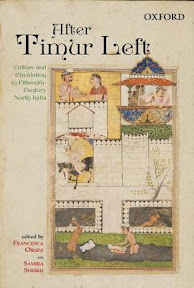After Timur Left
Orsini, Francesca [u.a.] [Hrsg.]:
After Timur Left : Culture and Circulation in Fifteenth Century North India / ed. by Francesca Orsini and Samira Sheikh. - New Delhi : Oxford University Press, 2014. - xii, 500 S. : Ill.
ISBN 978-0-19-945066-4
Rs. 1350,00 (OUP India)
US$ 75,00 (OUP USA)
DDC: 954.024
-- Angekündigt für Oktober 2014 --
Beschreibung
Timur invaded northern India in 1398 but returned to Samarkand a year later. In 1555 the Timurid emperor Humayun came back to India after being forced into exile in Persia and re-established Mughal rule in northern India. Between these two significant dates stretches an era largely consigned to oblivion—the 'long' fifteenth century.
The Mughal dynasty has long occupied a pre-eminent position in research on Indian history. It has also been credited with ushering in a radically new age of innovation in art, literature, and statecraft. But what of the period before the Mughals? With the empire-centred study of history privileging periods of political centralization, the multi-centred fifteenth century has remained relatively unexplored and undervalued.
After Timur Left presents a path-breaking interdisciplinary set of writings on the politics, languages, religions, literatures, and arts of the fifteenth century. Together they reveal it to be a period of considerable political and social mobility, of cultural connectivity and consolidation, of innovation in literature and language choices, and of new forms of religious organization and expression. [Verlagsinformation]
Herausgeberinnen
FRANCESCA ORSINI is Professor of Hindi and South Asian Literature at the School of Oriental and African Studies, University of London. Profile page.
SAMIRA SHEIKH is Associate Professor of History at Vanderbilt University. Profile page.
Quellen: Oxford University Press (India); Oxford University Press (USA); Bookbutler; WorldCat
Bildquelle: Oxford University Press (India)
Bibliographie: [1]
References
- (2014). After Timur Left: Culture and Circulation in Fifteenth Century North India. xii, 500 S.
Ähnlich
- Llewellyn-Jones: Last King in India
- Fischer-Tiné: Shyamji Krishnavarma
- Biedermann: The Portuguese in Sri Lanka and South India
- Cederlöf: Founding an Empire on India's North-Eastern Frontiers
- Kingship in Kaśmīr (AD 1148–1459)
- Francis: Le discours royal dans l'Inde du Sud ancienne 1
- Horstmann: Jaipur 1778
- Avelar: História de Goa
- Paranjape: Making India
- Kumarasingham: A Political Legacy of the British Empire

